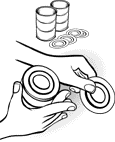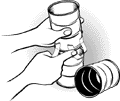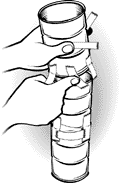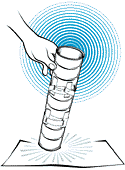|

|


-
tin cans (you'll need at least 3 cans
of the same size
-
can opener
-
sturdy tape (masking tape is okay, but
plastic packing tape or duct tape works best)
-
towel
-
wooden spoon
-
pencil
|
|
|
Tips on Cans:
-
Bonkos made from cans of different sizes will all sound different.
Try making Bonkos from little cans (like soup), bigger cans (like dog food),
or really big cans (like tomato juice or Hawaiian Punch). With a set of
Bonkos, your whole family can make some interesting music together.
-
You can plan ahead and save your cans as you use them. Or you can do
what the Fowler family did--plan a special dinner of canned foods and create
your Bonkos after you eat.
-
Make sure that your cans have flat bottoms that you can cut off with
a can opener. Cans with rounded bottoms won't work.
|
|

 Ask a grown-up to use the can
Ask a grown-up to use the can
 opener to cut off the bottoms of all of the cans-except one. Leave
the bottom on that one. (If you're using different sizes of cans, make sure
one can of each size has a bottom.)
opener to cut off the bottoms of all of the cans-except one. Leave
the bottom on that one. (If you're using different sizes of cans, make sure
one can of each size has a bottom.)
 Wash the insides of the cans and let them dry. (
Be
careful of the cut edges: They might be sharp.
)
Wash the insides of the cans and let them dry. (
Be
careful of the cut edges: They might be sharp.
)
 Take a can that still has a bottom
Take a can that still has a bottom
 and put it on the counter, open end up. Put another can of the
same size on top of it. Tape them together.
and put it on the counter, open end up. Put another can of the
same size on top of it. Tape them together.
|
 Put the next can on top of the
Put the next can on top of the
 other
two, and tape it to them. Now you have a Bonko that's three cans long, with
one closed end and one open end. (You can also make a four- or five-can
Bonko if you have enough cans.)
other
two, and tape it to them. Now you have a Bonko that's three cans long, with
one closed end and one open end. (You can also make a four- or five-can
Bonko if you have enough cans.)
 Put a towel down on your
Put a towel down on your
 kitchen
floor. Hold your Bonko open end up, and bonk it up and down on the towel.
Try making different sounds. You can make your own rhythms by bonking faster
or slower, softer or harder. If you hold your hand over the opening as you
bonk, does that change the sound?
kitchen
floor. Hold your Bonko open end up, and bonk it up and down on the towel.
Try making different sounds. You can make your own rhythms by bonking faster
or slower, softer or harder. If you hold your hand over the opening as you
bonk, does that change the sound?
|
|

Why does a long Bonko make a deeper sound than a short Bonko?
Compare two Bonkos that are made of cans of the same size. You'll find
that the longer Bonko makes a lower-pitched sound than the shorter Bonko.
Rather than talking about pitch, scientists sometimes talk about a sound's
frequency. Every sound begins with a vibration, and a sound's frequency
is the rate of vibration-the number of times something vibrates in a unit
of time. Something that's vibrating very fast-like the steam rushing out
of a whistling teakettle or the metal of a tiny bell-makes a high-pitched,
high-frequency sound. Something that's vibrating more slowly-like the drumhead
of a bass drum or the metal of a big bell-makes a low-pitched, low-frequency
sound.
When air inside a Bonko vibrates, it makes a sound that contains many
different frequencies. This complex sound bounces around inside the metal
tube. Sometimes vibrations of the same frequency overlap and add together.
When that happens, sounds with that frequency get louder. The length of
the Bonko helps determine which sounds get louder. Long Bonkos amplify low-frequency
(low-pitched) sounds; short Bonkos amplify high-frequency (high-pitched)
sounds.
|
|

Have you ever seen an instrument like the Bonko? Maybe not in America.
But all over the world-- from Africa to South America-- people use objects
just like your Bonko for dances and special ceremonies. Some of these tubes
are only about a foot long, but others are as tall as a grown-up man. People
who study music call them all
stamping tubes.
Each culture has its
own name for this instrument.
|

|
|
In
Venzuela
, they are called
quitiplas
and are made out
of cane or hollow wood.
|
In
Kenya
and
Tanzania
, they are called
bazaras.
They are made out of bamboo, sometimes with slits cut in the sides. People
pound them on the ground, but they also hit them with sticks to make a different
sound.
|
In the islands of
West Java
, they are called
kendang awi.
These are made of bamboo, and two of them-- one large, one small-- are played
together.
|
In
Borneo
, pieces of dried fruit are put into tubes of bamboo
so that the tubes will also rattle when they hit the ground.
|

|
This and dozens of other cool activities are included
in the Exploratorium's Science Explorer books, available for purchase
from our
online
store
.
|
|

|
Published by Owl Books,
Henry Holt & Company, New York,
1996 & 1997
ISBN 0-B050-4536
&
ISBN
0-8050-4537-6
,
$12.95 each
|
|

©1998
Exploratorium
|
|